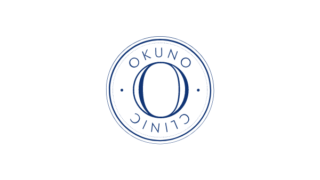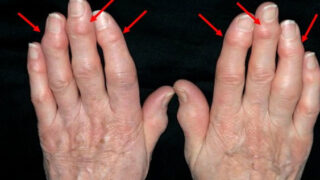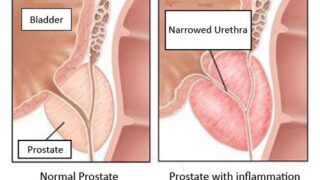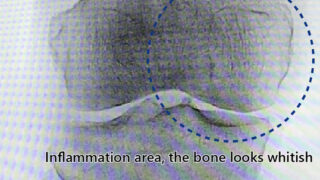Table of Contents
Q What is Gout?
Gout is a disease caused by the accumulation of uric acid crystals in the joints, leading to inflammation. The main symptom is acute joint inflammation, usually appearing as pain and swelling at the base of the big toe. The pain is intense, the area becomes red, and even a slight touch can be painful. Attacks may also occur in the ankle, top of the foot, Achilles tendon, knee, or wrist. After an acute attack, uric acid crystals may remain in the joints, potentially causing chronic pain or joint damage.
What causes gout?
Gout results from excess production or inadequate excretion of uric acid, leading to hyperuricemia. Contributing factors include:
- Diet: High-fat meals or foods rich in purines (organ meats, red meat, beer, etc.) can increase uric acid.
- Lifestyle factors: Obesity and excessive alcohol intake, especially beer, raise the risk.
- Kidney dysfunction: Poor kidney function reduces uric acid excretion.
What is uric acid level?
Uric acid level indicates the concentration of uric acid in the blood. Uric acid is produced when purines are broken down, which come from both body metabolism and foods like dried fish, shellfish, and beer. High uric acid is a major cause of gout and can also lead to kidney problems or stones, so early detection is important.
Why do gout attacks occur when uric acid increases?
When uric acid levels are high, crystals form and accumulate in joints, especially in cartilage areas like the feet and knees. These needle-shaped crystals can break apart due to movement, triggering an immune response where white blood cells attack them, causing inflammation, redness, swelling, and severe pain.
What are the main causes of high uric acid levels?
About 70% of purines come from the body itself, and 30% from food. Factors include:
- Genetics: Some people are predisposed to improper uric acid metabolism.
- Diet: Foods high in purines (liver, dried fish, beer, etc.) raise uric acid.
- Alcohol: Inhibits uric acid excretion; beer is especially problematic.
- Kidney dysfunction: Impairs uric acid elimination.
- Obesity: Increases uric acid production.
- Diseases/medications: Diabetes, hypertension, diuretics, and chemotherapy drugs can raise levels.
What tests are done at the hospital? Which department should I go to?
Doctors will check symptoms and joints, then conduct blood tests to measure uric acid, as well as urine tests, ultrasound, X-rays, and CT scans. In difficult cases, fluid from the joint may be tested for crystals. Internal medicine (general or rheumatology) or orthopedics are appropriate departments.
Q Are there early signs or symptoms of gout?
Patients may feel discomfort or tingling in joints before a full attack.
Is gout hereditary?
Both genetics and environment play roles. Family history increases risk, but diet and lifestyle changes can help reduce it.
**New Evidence That Gout Strongly Runs in Families (December 2, 2013 – University of Nottingham)
Can women get gout?
Women are less likely due to hormones promoting uric acid excretion. However, post-menopausal women are at increased risk.
**Gout and Nucleic Acid Metabolism, Vol. 26 No. 2 (2002): 119–124
It's been a month since my gout attack, but the pain persists. Why?
Normally, attacks subside in 1–2 weeks. Persistent pain may mean improper treatment, noncompliance, or chronic inflammation from remaining crystals. It could also suggest another condition. A new treatment called arterial injection therapy offers relief in some cases.
How can I relieve a gout attack quickly? What happens if I leave it untreated?
Without treatment, pain can last over a week. Early medication is essential—NSAIDs, colchicine, and corticosteroids are effective but usually not sold over the counter. Other remedies include rest, elevation, cooling, and hydration. Long-term control requires starting uric acid–lowering medications.
Q What foods help prevent gout? What should be avoided? Is coffee effective?
Recommended: low-purine foods, dairy, eggs, grains, tofu, mushrooms. Coffee may reduce gout risk according to some studies.
Avoid: high-purine foods (liver, dried fish, shellfish), alcohol (especially beer), sugary drinks.
**ACR Open Rheumatology, Vol. 4 Issue 6 (2022): 534–539
Q What medications can lower uric acid levels?
There are medications that lower uric acid levels by either suppressing its production or promoting its excretion, and these are effective for the treatment of gout and for protecting the kidneys. However, diagnosis and prescriptions must always be made by a doctor.
**Japanese Guidelines for the Management of Hyperuricemia and Gout, 3rd Edition
While most of the most effective medications for gout are available only by prescription, over-the-counter options during recurrences include NSAIDs such as loxoprofen or ibuprofen, and acetaminophen if NSAIDs are not suitable.
Consultation
Some patients continue to experience recurring gout attacks despite ongoing treatment. In such cases, it is believed that a local environment prone to gout-related inflammation has developed.
Recently, a simple and minimally invasive treatment called intra-arterial infusion therapy has been introduced to help prevent these repeated attacks. This procedure involves injecting medication—typically antibiotics—directly into an artery near the ankle using a very thin catheter (similar to one used for IV drips). The treatment takes about five minutes and places minimal strain on the body.
For more information about our newly introduced Arterial Injection Treatment, please refer to the following link:
Author

-
I began my career as an interventional radiologist, which led to my research on pathological angiogenesis during graduate school. As first author, I published findings on related genes in Nature Medicine in 2012. Based on this work, I developed a novel embolization treatment for chronic musculoskeletal disorders, such as knee osteoarthritis and frozen shoulder, and was the first to report its safety and effectiveness. This approach is now being studied internationally.
-Career-
2006-2009 Fellow, Department of Radiology, Clinica ET, Yokohama, Japan
2009-2012 Researcher, Center for Integrated Medical Research, Keio University, Tokyo, Japan
2012-2015 Clinical Researcher, Department of interventional radiology, Edogawa Hospital, Tokyo, Japan
2015-2017 Director, Musculoskeletal Intervention Center, Edogawa Hospital, Tokyo, Japan
2017- Chief Director, Okuno Clinic., Tokyo, Japan
Latest posts
 Sep 12, 2025Gout FAQ
Sep 12, 2025Gout FAQ May 30, 2025Heberdens Nodes FAQ
May 30, 2025Heberdens Nodes FAQ Dec 27, 2024Prostatitis FAQ
Dec 27, 2024Prostatitis FAQ Dec 27, 2024Knee Osteoarthritis FAQ
Dec 27, 2024Knee Osteoarthritis FAQ